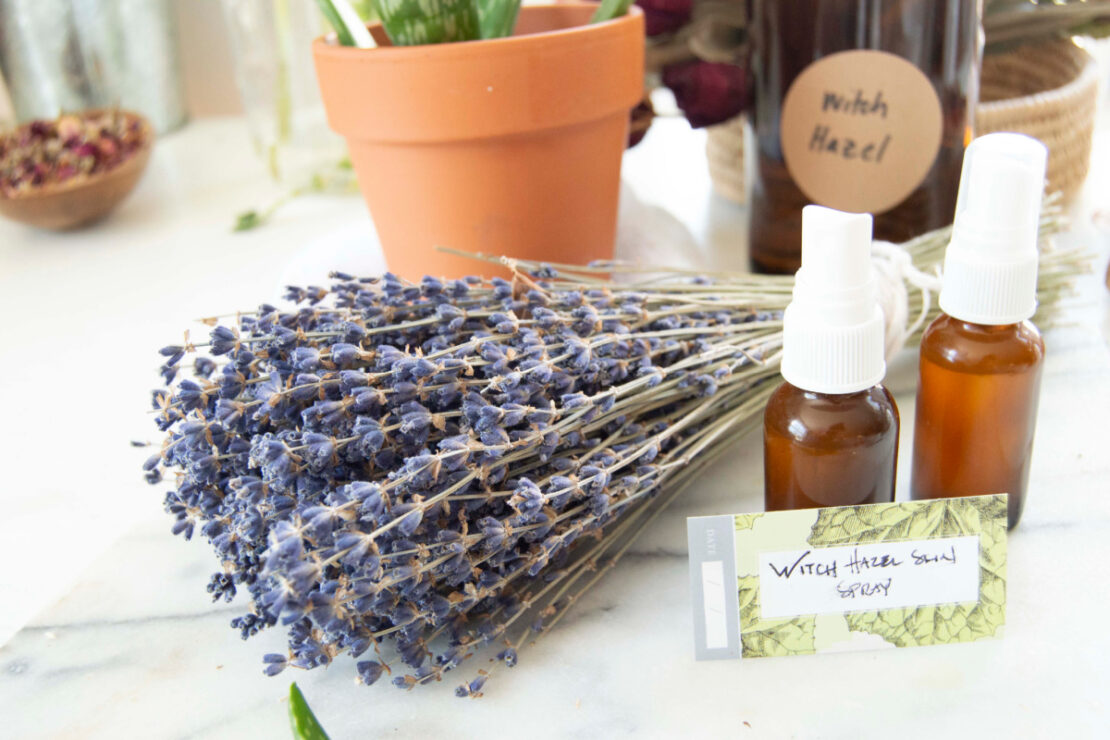
Teenage Skin Care: Herbal Recipes & Simple Routines
When it comes to teenage skin care less is more, despite parental urges to fix, research, and monitor. This is especially true when working with oily skin, which is usually part of the picture for teen skin troubles. The less is more approach has even more merit in hot or humid weather, and when stress and hormonal changes are a factor for teens. Assuming that teen skin care often means minimizing breakouts, redness, and even painful reactions, it’s common for teens (or any person who experiences visible blemishes) to be greeted daily with a barrage of well-meaning advice. Best intentions from home remedies to high-end products can sting—emotionally, and physically.
Keep It Simple
Teens and other acne sufferers benefit most from one or two simple supports which can be done consistently. Simplicity and consistency are most important because the skin will respond to its environment, including anything that is applied topically, whether for a short or long time. Lifting oil and debris from the skin daily, consistently, will be helpful to teen skin. Take away too much of the skin’s protection and sebaceous glands will respond, perhaps producing even more oil. Adults who have zeroed in on a skin care routine may be accustomed to collecting the set: cleanse, exfoliate, tone, moisturize, protect. Teen and sensitive skin might not respond well to all those products. Dialing in just one or two of these steps to create balance may be just as helpful, or even more beneficial than a complicated skincare routine…
Testosterone, T-Zone, and the Teen
Teens experience a period in life when the body is dialing up the production of hormones and the rest of the body responds. This is why we often see mood swings, rapid changes in body composition, and skin issues in teens. Testosterone production increases in all teens during puberty. Testosterone stimulates the production of the oil sebum, which protects the skin. Out of balance, this can lead to inflammation of the sebaceous glands, and acne. When oily skin, inflammation of the sebaceous glands, a poor reaction of the skin to its natural oils, or other dysregulations of this system occur it is best to approach with these goals in mind:
- Reduce excess oil production and/or cleanse the skin of excess oil 1-3 x daily
- Support healthy balanced function of the sebaceous glands
- Reduce inflammation
Additionally, yeasts and other microbes live on healthy skin, though can become out of balance on skin that is especially oily. Herbs that match the three goals, plus have gentle antimicrobial activity. can be an especially supportive choice for teen skincare.
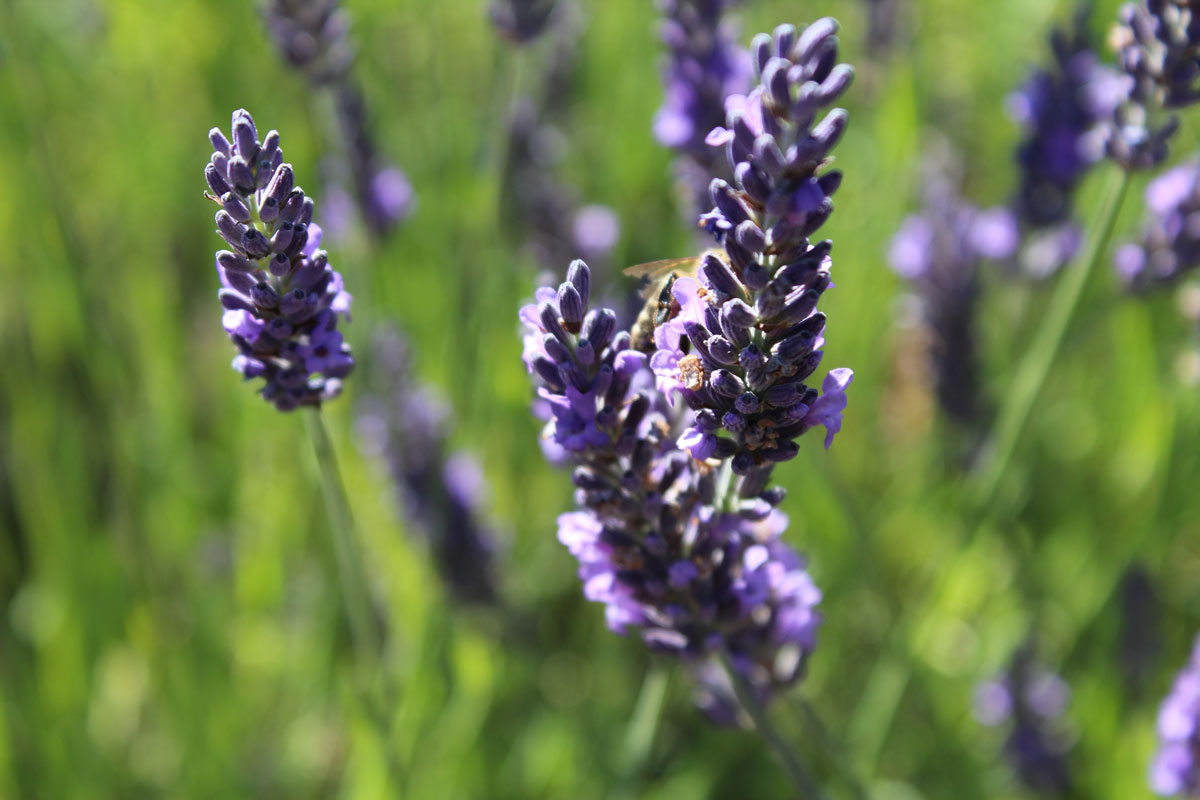
Herbs for Teenage Skincare
Herbs which are astringent, antimicrobial, and have an affinity for balancing the sebaceous gland’s activity plus reduce inflammation include willow (Salix spp.), witch hazel (Hamamelis virginiana), yarrow (Achillea millefolium), tea tree (Melaleuca alternifolia), and lavender (Lavandula spp.). There are certainly others. We will focus on these five, with simple recipes incorporating one or more of these herbs as main ingredients.
Willow (Salix spp.)
Willow (Salix spp.) delivers a combination of benefits when it comes to caring for teen skin troubles. In addition to astringency and anti-inflammatory action, willow bark and leaf contain salicylates. Salicylates, named for the willow genus Salix, are constituents with similarity to salicylic acid. You may recognize salicylic acid as an active ingredient for topical applications. Salicylic acid is said to facilitate and speed the process of shedding dead skin cells. This may also be relevant to cells that have lost healthy function and become rough, red, and irritated. Willow preparations may soothe and renew blemished skin, acne, and boils, reducing these irregularities and making way for new skin cells and a chance to heal, especially when gentler techniques don’t make a difference. This is not to say willow is always the answer.
Willow is best used for short periods of time when most needed. That is to say, a teen might use a willow preparation for several months but not necessarily for years. This is simply because of its potential quality of encouraging the skin to shed layers, a process that can be helpful while restoring healthy function, after scabbing or scarring, but possibly not ideal for continuous use long term.
Teens going through a rough patch with skin health may benefit from a daily liniment or wash of willow bark. This can be used as a cleanser and astringent for oily areas: face, back, and neck. I have also used a bit of willow tincture or powdered willow bark or leaf as a compress over stubborn blemishes. This also works well for restoring rough areas left behind by skin breakouts. A concentrated preparation of willow may also be used to encourage softening the skin and resolution of the most stubborn and menacing pimples.
Despite the generally great match that willow is for common teen skin troubles, there is a small percent, perhaps around 3% according to clinical research, of people for whom willow is not an option. Occasionally allergic reactions have been noted, which tend to end after use is discontinued. As with any topical application, a small patch test on a less sensitive, less visible area such as the inside of the arm, can be a wise first step before using an herb, wash, or other application on sensitive facial skin.
Once you have patch tested willow (Salix spp.) leaf or bark in the form you plan to use it, you may like to know a few ways to combine it with other herbs. Remember what we said. Keep it simple. Here is one easy recipe out of hundreds, simple to advanced, from our Botanical Skincare Course and Botanical Skincare Recipe Book. The addition of zinc further supports healthy function of the sebaceous glands, and clay can help lift excess oil, dead skin, and debris from problem areas.
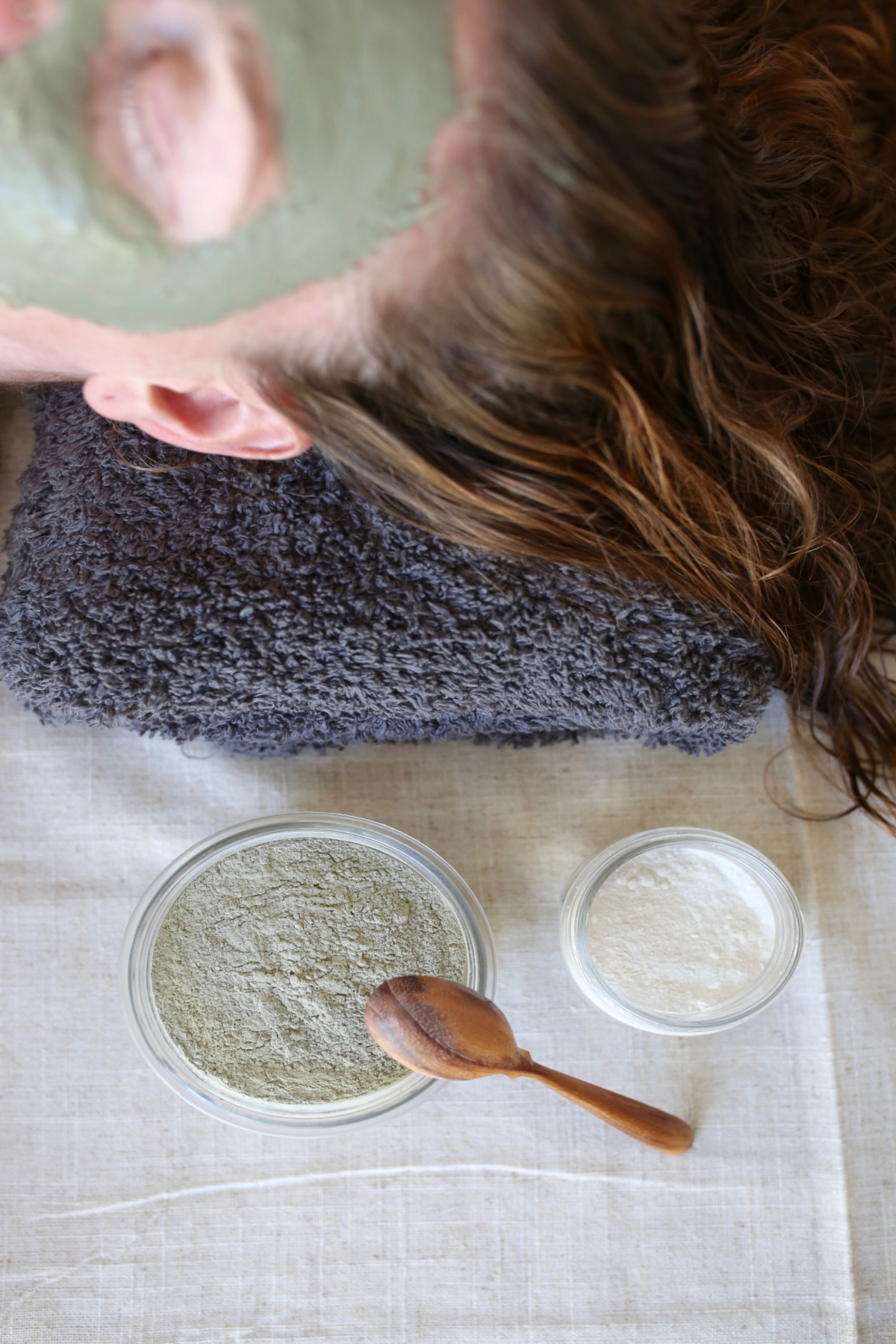
This could be used as a spot treatment for blemishes or occasionally as a mask for oily skin prone to redness. The powder will store indefinitely if you take care to only moisten the portion you will use at a given time. You may want to scale the recipe up to make a bigger batch.
1 tablespoon French green clay (other types of clay can be used in place of French green clay)Clay, Willow, and Zinc Mask
1 teaspoon willow (Salix spp.) bark powder
¼ teaspoon zinc oxide powder
Remember you can also use willow bark or leaves in even simpler ways, such as as a fresh infusion that you then use the same day to wash and tone your skin. The whole range of species can be used. Tinctures can be diluted to make a liniment that you can then spray or pat onto your skin. You will find many more great ways to use willow bark in the Botanical Skincare Course and Botanical Skincare Recipe Book.
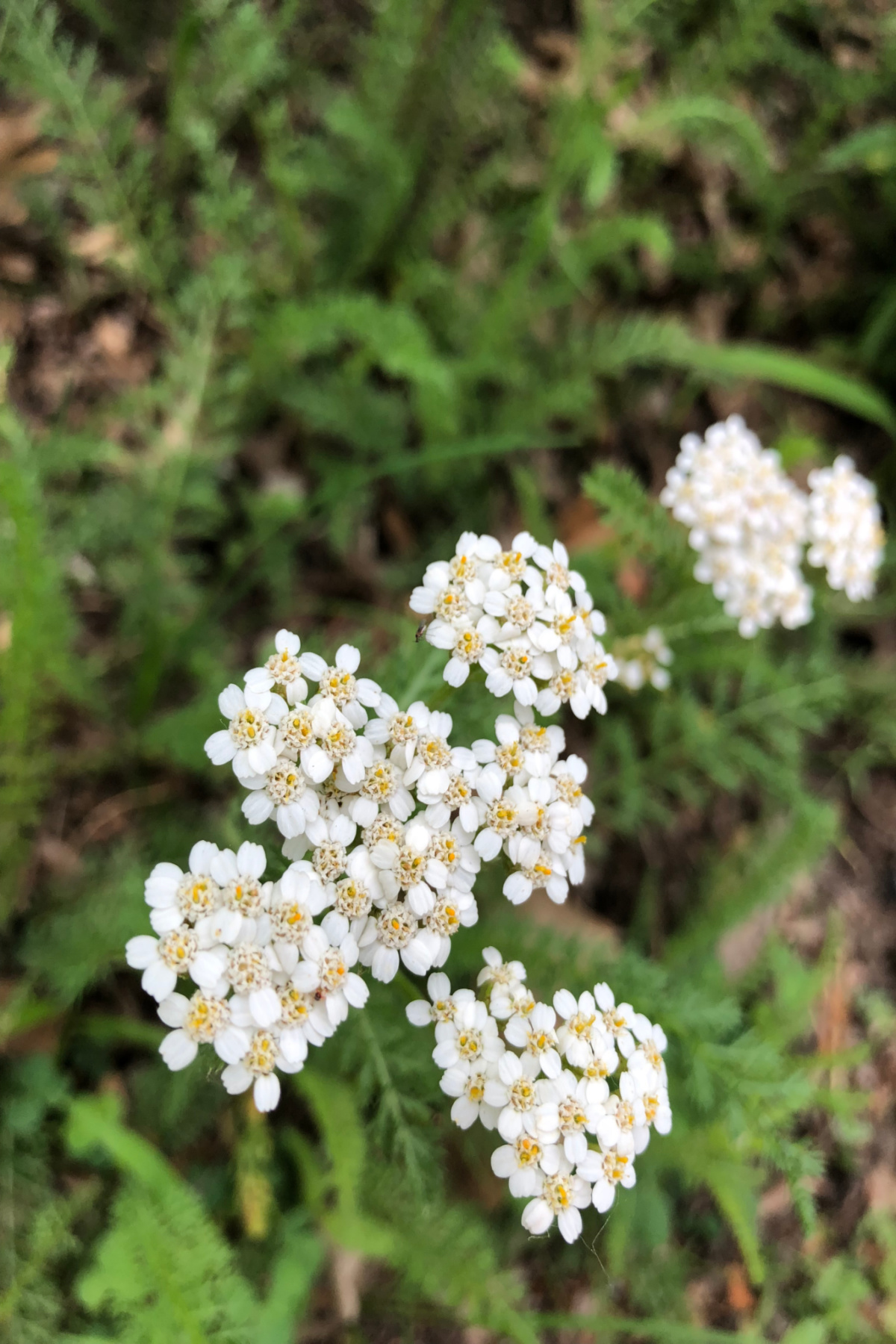
Yarrow (Achillea millefolium)
If you find that willow is not your herb, or you would like additional ideas, yarrow (Achillea millefolium) is also very versatile. Like willow it is widespread, though being a herbaceous plant it is much easier to wild harvest, and it can be grown in a season or two. The leaf, flower, and stem can all be used, though if you are drying and powdering yarrow the leaf and flower will powder finer and softer than the stem. These parts are also more potent than the stem. For willow bark, the harvest is a bit more tedious than for yarrow.
Antiseptic, anti-inflammatory, and astringent, yarrow has at least one additional special action; it has been called an alterative, meaning a substance that helps purify the blood and detoxify the skin. How you may ask? Yarrow topical applications seem to encourage circulation close to the surface of the skin—that is when the skin is not broken. When the skin is broken it is said to be a styptic. When circulation is encouraged, impurities are carried away more efficiently, and natural metabolic byproducts are also carried away faster. Additionally, my personal experience is that yarrow can temporarily lessen itchiness. This is an attractive positive side effect when trying to avoid touching troubled skin areas under the judgy watch of onlookers. You can use yarrow similarly to willow. Plus, it seems less likely to provoke allergies or side effects. Try a wash, steam, poultice, bath, or press yarrow infusion or tincture onto the skin once daily. You can also make small batches of infusion and apply with a mist bottle (handy for large or hard-to-reach areas like the back). Store this in the refrigerator for a couple of days only, renewing the contents and washing the container between uses. No fun you say? You wanted a recipe? Here we go:
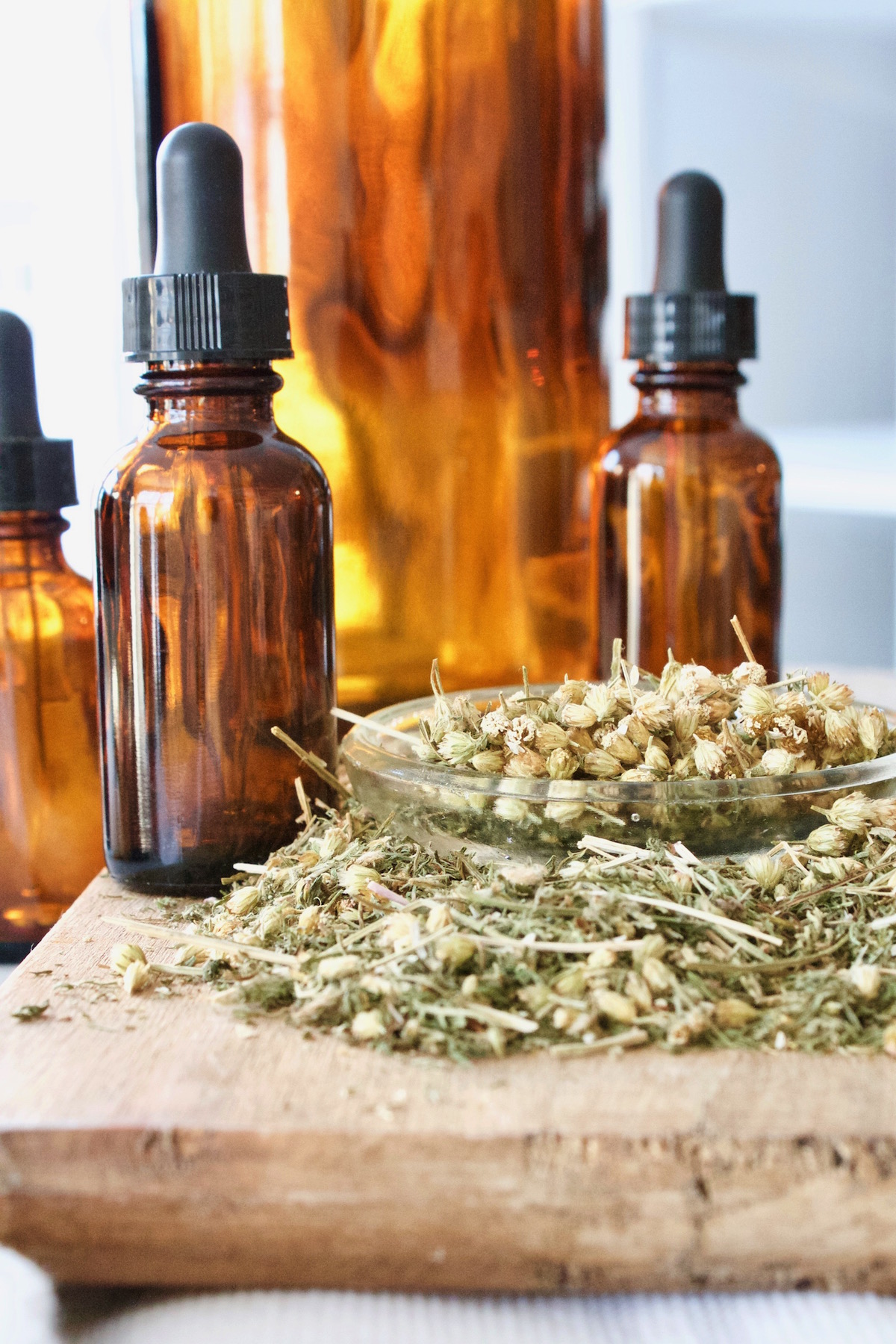
Designed to refresh blemished bodily and/or facial skin, this can be sprayed or wiped over sweaty, oily, or affected areas. It is especially nice in hot, humid weather!
1⁄4 cup (2 fl oz) yarrow (Achillea millefolium) hydrosolToning, Cooling Astringent For Oily, Blemished Skin
1⁄8 cup (1 fl oz) yarrow (Achillea millefolium) aerial parts tincture
1⁄8 cup (1 fl oz) witch hazel (Hamamelis virginiana) bark extract
Do you remember we were going to keep it simple? If you didn’t have all three of the ingredients above you could still make a preparation with two out of three listed ingredients, as long as the result is at least 20% alcohol to preserve the solution, that is to keep it from harboring bacteria. If you have another simple hydrosol or extract that you want to use that agrees with the skin, you could substitute. Rose (Rosa spp.), lavender (Lavandula spp)., and sage (Salvia officinalis) are great candidates to switch out for the yarrow hydrosol or witch hazel extract.
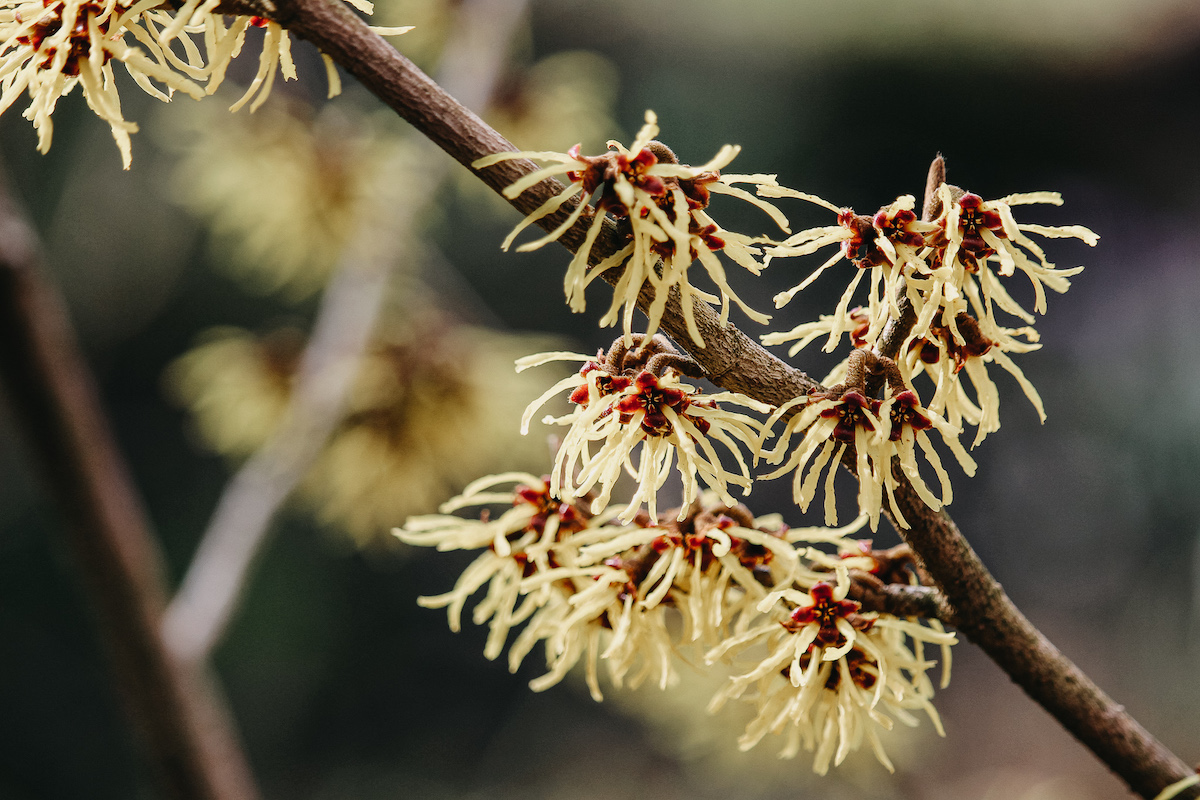
Witch Hazel (Hamamelis virginiana)
Here we go! Witch hazel. Were you going to ask about this one? Here we are at yet another astringent. The familiar pharmacy product ‘witch hazel’ that you may be used to or intrigued by can be used as a base for astringents and washes. Though it is largely alcohol, it also contains distilled leaves, flowers, and twigs of witch hazel (Hamamelis virginiana). You can also use the fresh leaves of this plant to enhance your herbal preparations. For example, you might use the over-the-counter topical product as part of the water and alcohol base of a facial toner or wash, and you might additionally use a tincture of witch hazel leaf that you made as an ingredient. Or, extract the leaves in the over-the-counter solution to potentize it. Witch hazel extract in the recipe above refers to the common over-the-counter topical astringent solution.
But wait, can’t astringents be too drying? Alcohol can strip the skin of too much oil and generally dehydrate the skin’s surface. However, in small amounts, it can be helpful to oily skin. Additionally, plant astringents, particularly witch hazel (and rose could be included) seem to help balance the skin’s ability to regulate moisture and oil. While you may crinkle your nose at the thought of witch hazel if you have dry or only medium oily skin, it can supply the right umph for very oily and teen skin, and is still a bit more sophisticated, balancing, and gentle than pure alcohol toners.
There are so many ways witch hazel can be integrated into recipes. Here is one recipe featured in the Botanical Skincare Course and it was inspired by the book Natural Beauty by Karen Gilbert.
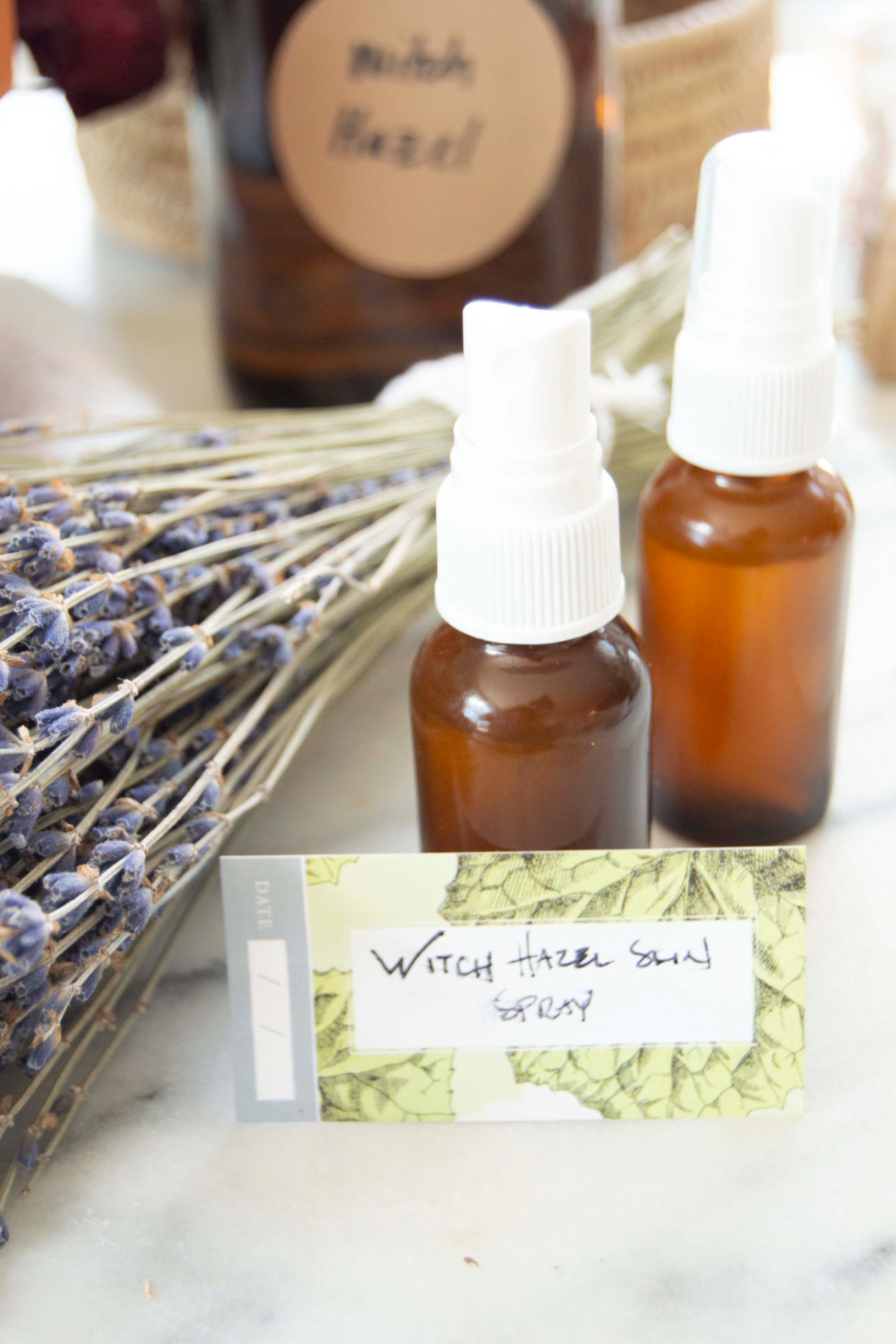
An astringent skin toner to tone skin after washing.
Adapted from Natural Beauty by Karen Gilbert (Gilbert, 2013).
2 teaspoons witch hazel (Hamamelis virginiana) bark extractLavender and Witch Hazel Oily Skin Toner
5 tablespoons (2.5 fl oz) lavender (Lavandula spp.) hydrosol
½ teaspoon yarrow (Achillea millefolium) aerial parts tincture
½ teaspoon vegetable glycerin
The glycerine in this recipe can feel a bit sticky on the oiliest skin types. This will be especially noticeable in hot and humid climates, as glycerine is a humectant—it draws moisture in. But we still love this recipe because it combines many of our teen skin care superstars, and for oily skin it is much preferred to oil-based carriers.
Lavender (Lavandula spp.)
Lavender (Lavandula spp.), as we are often reminded, whether on plant walks or in blog posts, or by that whimsical lady handing out samples in the supplement aisle, is named for the Latin word lavare “to wash.” Lavender is gentle yet potent when it comes to skin care. Said to be cooling, lavender seems to reduce redness and yet promote circulation in the skin. It is even said to be useful with skin that is couperose, red, with delicate blood vessels, and sometimes blistered. This is yet another herb that can be applied as a gentle wash and or toner. Or, a fresh infusion can be pressed to the skin on a clean cloth for 5 to 10 minutes at a time. (Start with a little bit shorter period, like 1 minute, as a test.) In my experience, the benefits far exceed that of water and pressure alone, and in many cases this simple application does more than any commercial product.
Lavender is rich in aromatic oils, and simple preparations can be quite stimulating in a positive and safe way. Clinical studies have shown lavender essential oil’s effectiveness against bacteria that commonly colonize the skin. These bacteria can become overgrown and lead to visible problems. However, I’m suggesting the most gentle preparations such as hydrosols, steams, infusion or decoction used as a wash, toner, or bath once cooled. Remember that our goal is to exert a positive influence on the skin that it can respond to and not overcompensate to. Furthermore, ideally the routine will be gentle, sustainable, and will only adjust the current state of the skin slightly, to bring flora, circulation, and sebum production back into balance. Lavender has even been used for scar support, which is not to suggest definite effectiveness, but because teen acne can be associated with minor scarring or pocks in the skin, lavender is looking like a good match all around!
Lavender is featured in the earlier recipe and we will give you one more from the Botanical Skincare Recipe Book.
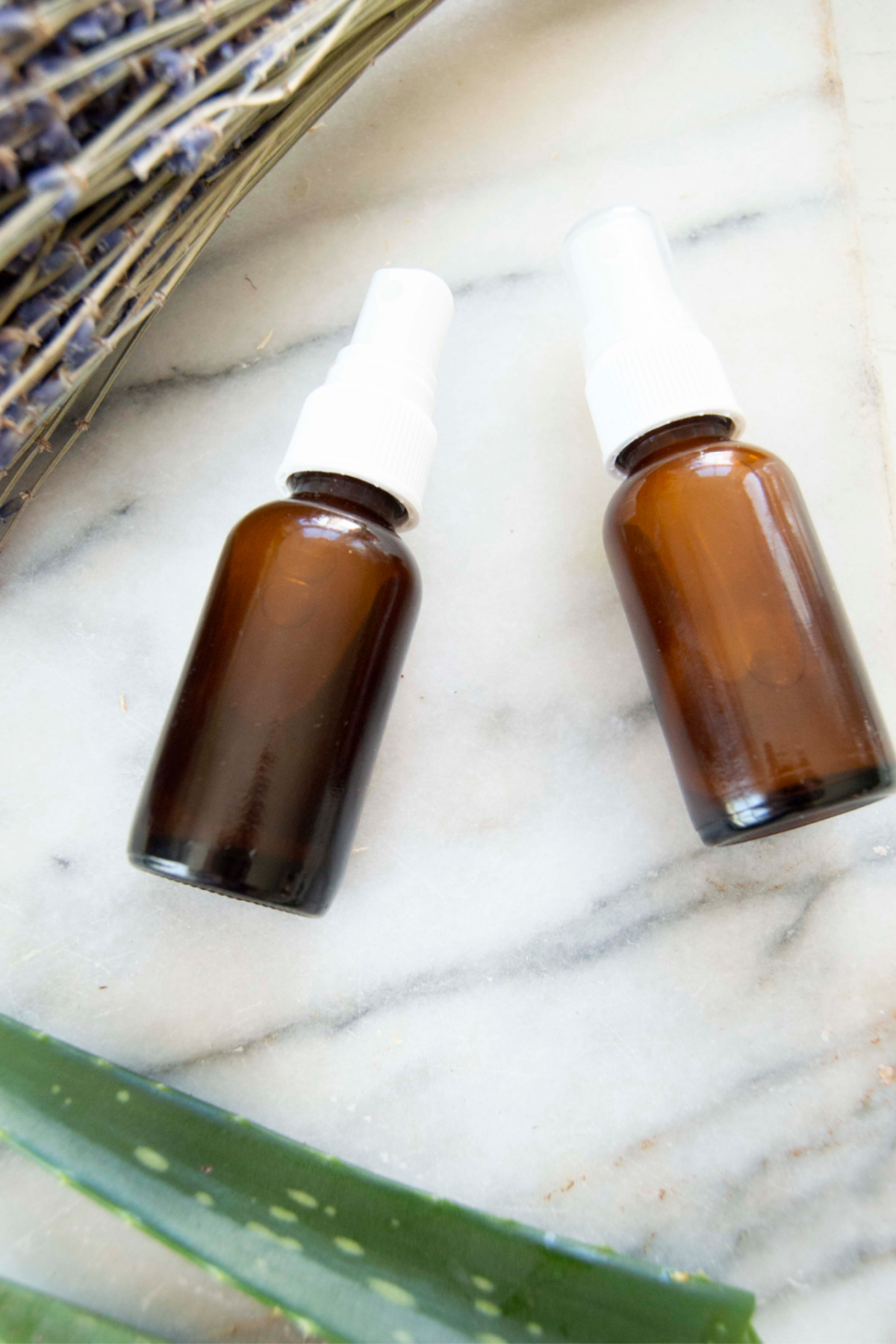
Astringent and anti-inflammatory willow bark makes an excellent base for a facial toner. It works especially well for acne-prone skin, perhaps because of its salicylate content. Lavender and rose hydrosol both offer additional anti-inflammatory and vulnerary power, and depending on your preference, add a lovely scent as well!
Clarifying Facial Toner
¼ cup (2 fl oz) lavender (Lavandula spp.) or rose (Rosa spp.) hydrosol
Tea Tree
Perhaps even more potent than any of the four herbs prior, and with similar benefits; anti-inflammatory, antimicrobial, astringent, circulatory increasing, cooling, and having an affinity for the skin, tea tree (Melaleuca alternifolia) can be considered an oily skin and teen skin ally. It is important not to use too concentrated or harsh of a preparation though. Once again we are interested in some effective cleansing but to the extent that the skin’s natural responses can come to balance with the routine. For tea tree, you won’t often be working with the raw herb unless you live in a region where it grows. If so, do let us know how you enjoy using it! For most of us, we will be relying on tea tree oil in combination with a carrier or soap. Soap is a great use for this slightly more potent ingredient as it will be rinsed off.
Here we have a simple cleanser recipe. Though you won’t necessarily want to use or suggest castile soap for dry skin, for oily and teen skin it can provide just the right amount of cleansing power. Add ingredients that you have learned about here or in the Skincare Course and you will have an ideal combination for teens and others who may experience oily or oily/combination skin, or who are going through some hormonal balance bumps and need effective though gentle cleansing, toning, and balancing.
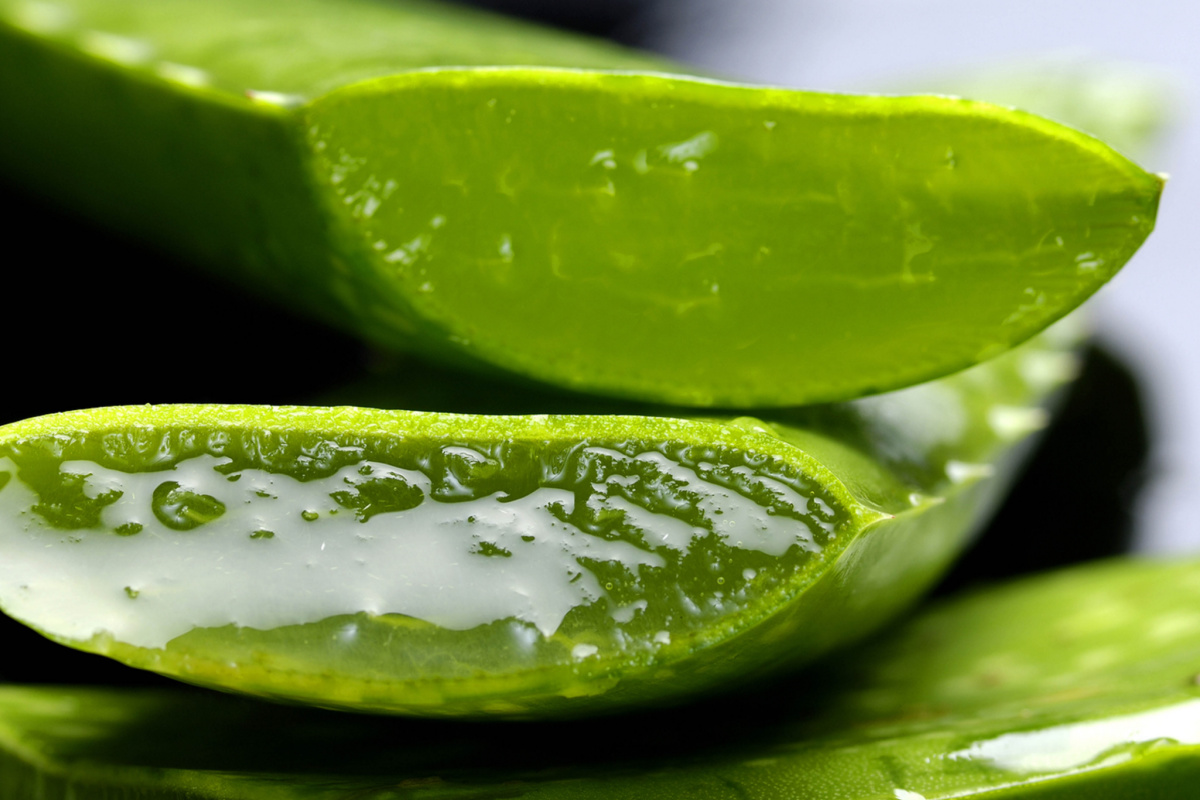
Adapted from Natural Beauty Alchemy by Fifi M. Maacaron (Maacaron, 2015). 1 teaspoon vegetable glycerinToning Witch Hazel Cleanser
This gentle, foaming cleanser is perfect for acne-prone skin (leave out the essential oil for an all-purpose skin cleanser).
2 tablespoon (1 fl oz) witch hazel (Hamamelis virginiana) bark extract
2 tablespoon (1 fl oz) aloe (Aloe vera) leaf gel
2 tablespoon (1 fl oz) castile soap
15 drops tea tree (Melaleuca alternifolia) essential oil (optional)
Habits and Patience
“Oh boy. Here comes the lecture…” sigh teens and others with oily and/or blemished skin.
“It’s probably something in your diet!”
Much has been written about conventional and alternative wisdom concerning which foods are “bad” for and which supplements are “good” for teen skin. Well-meaning friends, family, and sometimes strangers, are always willing to speculate too. To follow all of the advice you hear would be stressful in itself.
However, do relate these tips to how they may be reflective of your own tendencies. For example? Does chocolate cause acne? This is unproven. Yet, if you have a two-bar per day habit that may be something to look at. Without taking all the fun out of life, might you be able to slowly adjust what is normal and pleasurable for you and learn to enjoy a greater range of healthy foods?
Diet can definitely be a factor, and an obstacle to your skin healing, especially if there are foods that you eat every day that are often associated with acne or food sensitivity, or if you are not regularly eating the types of foods that help the body recycle hormones. In this case focus on greens, fibrous foods, hydration, and a healthy balance of protein compared to sugary foods. Blood sugar balance can affect hormones, mood, immunity, and skin health.

Vegetarians may additionally want to look at whether they are eating any foods rich in zinc, as this mineral helps the function of the sebaceous glands, and some vegetarian diets may tend to be low in zinc even though it does occur in plants. Though animal protein sources are generally richer in zinc than plants, a focus on zinc-rich seed-based foods can help balance this in a plant-based or vegetarian diet. Whole grains such as whole wheat, rye, and oats provide zinc, the germ of the seed containing 80% of the total content (Haas, 2006). The fiber in these foods offsets absorption of zinc slightly, but that fiber is beneficial to the skin and general health by balancing digestion, elimination, and detoxification. Nuts and seeds are another way to boost zinc in the vegetarian diet, though are best eaten in small to moderate amounts as they are also rich in oil and fat which in excess may imbalance teen hormones and teen skin issues. Hemp seeds, pumpkin, and other squash seeds, pine nuts, cashews, sunflower seeds, pecans, chia seeds, flax seeds, Brazil nuts, and almonds are especially high in zinc (Whitbread, 2020). A few spices are also zinc boosters, namely, ginger, mustard, chili powder, and black pepper (Haas, 2006). If any food from this list is not tolerated well, simply focus on the foods you enjoy and tolerate most. There are plenty of options for plant-based zinc boosters! The tough thing about resolving skin issues is that it can take time to see a truly gratifying improvement. I remember how it used to feel when strangers would comment with advice and sympathy while I was having a good skin day! Ugh! On top of this, setbacks happen overnight, or with one stressful event, and because of natural hormonal changes teens have little to no choice in, which can make it seem like intentional positive changes aren’t making any difference at all… at first!
There are also a few higher impact (in my opinion) practices. Did you notice that some of the herbs for skin health are thought to increase circulation in the skin, or balance skin flora? There are other practices that can make a big impact. Exercise quite frankly is all about improving circulation. Warmth (to an extent) and sunlight (to an extent) can also be beneficial. When we are warmer our circulation to our skin is slightly better, in order to cool down our core. Sunlight can help promote the ideal balance of natural skin flora.
Though heat can be, humid air is not necessarily helpful to skin with acne. Some natural fungi or yeasts that live on the skin and feed off of dead skin and oil may overproliferate in humid weather. I remember walking into a lepidopterarium (a butterfly house) at a museum that a friend from years past really wanted us to see together. Two teen women worked inside this humid museum exhibit and both had blistery red patches spotting their faces. I couldn’t help but think the humid environment wasn’t helping them, if not the cause. Sometimes environment is the root cause and there may be little you can do at the time. This friend and I had had similar matching acne years past, probably work-place influenced. What a lot of advice we used to get from the glamorous busybody patrons who graced our roost—the beauty aisle of a natural health store! Despite having basically anything we wanted in the way of free high-end products at our disposal, the main thing that helped both of us was a good several months away from that job!
This is to say, habits and environment do matter, but sometimes you might have to wait it out a bit.
In Closing,
Remember that if you have blemished skin, it might not be anything you are doing wrong, and time does change everything. However, you might be pleasantly surprised by a few simple changes, practices, and patience.
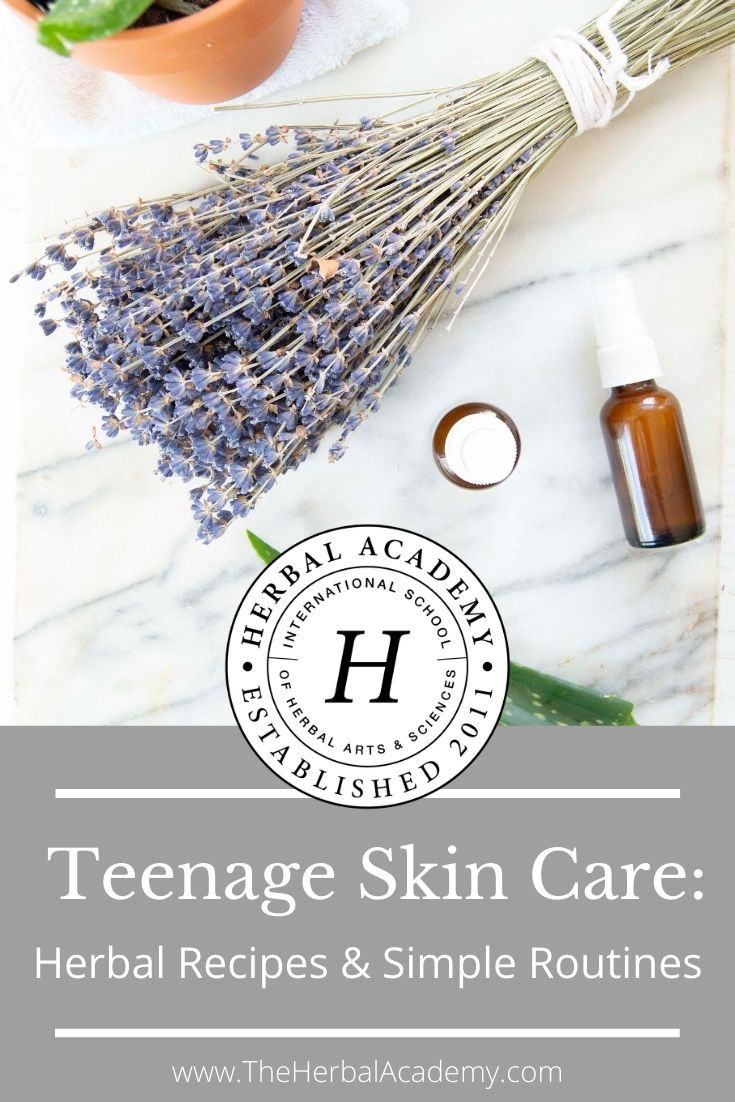
RESOURCES
Gilbert, K. (2013). Natural beauty. London, UK. CICO Books.
Haas, E. (2006). Staying healthy with nutrition. New York, NY: Ten Speed Press.
Herbal Academy. (2019). Botanical skin care recipe book. Bedford, MA: Herbal Academy.
Maacaron, F. (2015). Natural beauty alchemy. Woodstock, NY: The Countryman Press.
Whitbread, D. (2020). Top 10 nuts and seeds highest in zinc. My Food Data. USDA Food Data Central [Online Database]. Retrieved from https://www.myfooddata.com/articles/high-zinc-nuts-seeds.php








